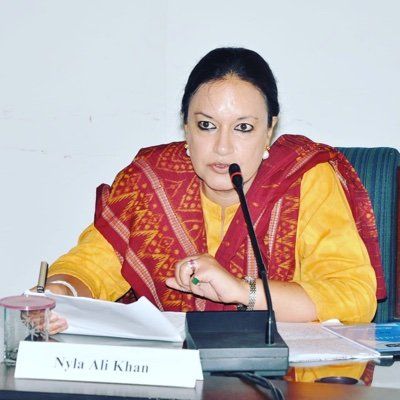Symposium on Allama Iqbal
Book Review by Ajay K. Mehra
THE PARCHMENT OF KASHMIR : History, Society and Polity, Edited by Nyla Ali Khan, 262 pp. New York: Palgrave Macmillan.
This collection of nine essays divided into five parts and glued together by an editorial Introduction, brings analytical reflections from as many Jammu and Kashmir scholars, which is parched in every sense of the word since decolonization of the subcontinent. In a brief but succinct Introduction, the editor, who herself belongs to the political ‘first family’ of the state, highlights difficulties of academically comprehending and grasping the phenomenon Kashmir and creating an understanding of this ‘simple complexity’ amongst future generations.
She highlights the multifaceted impact of this perpetual conflict on society in general and on women and children in particular and on generations to come. She refers to ‘Kashmiriyat’ as the multi-cultural spirit of coexistence and foundational strength of Kashmir. However, with most of the minority Kashmiri Pundits exiled to different parts of the country due to the xenophobic politics of terror pursued by some and the Government of India bumbling through available options, there is a communal divide that discussions on the two other parts of this three-part state – Jammu and Ladakh – cannot and must not escape. Essays in this volume combine personal experience as well as academic analysis. Naturally, the arguments arise from a mix of history, political developments, social consequences of conflict and victimhood.
No discussion on Kashmir can begin, let alone be complete, without an understanding of the construction of this identity over centuries, creating a multi-cultural salad bowl of Islamic, Saivic, Sufi and Buddhist ideals – concern of the first section in the book containing two essays by Mohammad Ishaq Khan and Rattan Lal Hangloo, both historians. Khan weaves an absorbing narrative of Kashmir from his birth and childhood to growing up, where personal differences did not turn into communal rivalries, despite a discriminatory Dogra rule, to its gradual slide into the politics of ‘jihad’, which was not part of its syncretic cultural ethos described as Kashmiriyat. Resulting securitization of J&K has brought in its wake not merely persistent inconvenience, but also indignities of a quotidian nature, which make any official claim of eerie normalcy hollow. Yet, Khan concludes on a positive note: ‘Notwithstanding banal attempts at distorting Islam and Kashmiriyat for sustaining the battered mainstream ideologies of India and Pakistan, still a vast potential underlies with my experience with Islam and history for the development of a realistic and practical approach to the crisis of identity politics in Jammu and Kashmir.’
Hangloo’s interrogation of Kashmiriyat, a concept that has ‘gained currency’ with armed insurgency despite fuzzy conceptual clarity and empirical reality, explores its various manifestations. Used mainly to underline communal harmony, multiculturalism, and the inter-community tolerance and coexistence, academic explorations of Kashmiriyat combine its roots in ‘homeland’ (kashir) and common speech (koshur) as well as similar customs and practices (T.N. Madan) and as ‘the gradual outcome of mutual adaptation the various pre-Islamic religious traditions and great tradition of Islam’ (M.I. Khan). What has been described as ‘a hotchpotch’ of various ideologies and anti-Islam by Islamist Suhail Showkeen, emerges simultaneously as a civilizational/cultural concept and a political project, which was distorted due to various streams of political rule, more particularly ‘by the fabrication in the mid-nineteenth century of the state of Jammu and Kashmir, a Hindu polity and its intrusion into the cultural life of the people of the Valley’. Hangloo brings out contradictions seeping into this civilisational concept, rather way of life, that has pervaded the people and the society over centuries with the arrival in the valley of people from a variety of civilisational streams, as different political projects took shape. He identifies the Dogra rule, the Indo-Pak conflict, India’s nation building assimilation project and militancy, which brought in several and severe cracks in the edifice of Kashmiriyat. His narrative also highlights that for some Islam is the cornerstone of Kasmiriyat, though he does not say it, but that does bring in paradox of a coloured vision that impacts syncretism as well as lends artificiality to the concept that has been promoted essentially to bring unity and peace.
Two chapters in the second section ‘Cultural Syncretism and Deconstruction of a Monolithic Culture’ complement the discussion on Kashmiriyat in the previous. In an attempt to identify the predominant spiritual tradition of Kashmir M.H. Zaffar attempts to outline how Saiv, Buddhist and Sufi traditions were interpreted by the Muslims and the Pundits; the same deity getting different names and continuing to be integral part of cultural lives of the syncretic society. Neerja Mattoo complements Zaffar’s arguments in her opening sentence: ‘As a Kashmiri Pandit woman growing up in Kashmir in the 1940s and 1950s, I was never aware of any difference between Muslim or Sikh girls of the same social class and me, either in the neighbourhood or in school And college.’ She demonstrates more substantially through her analysis of the practices of Saivism, Buddhism and Sufi Islam as well as compositions of legends such as Sheikh Nuruddin Wali/Nund Rishi, Lal Ded/Laleshwari (for Muslims and Hindus respectively) religio-cultural syncretism in Kashmir. These were further followed in the compositions of mystic Aziz Darvesh (d. 1819), Sufi mystic Shah Ghafoor (d. 1850), Rupa Bhawani (1625-1721), Khwaja Habibibullah Nowshera, Shams Faqir (1843-1904), who bridge couple of centuries, that seamlessly sang peans of the almighty weaving the traditions of both the religions without prejudice.
Part III of the collection debates ‘Conceptualization of Sovereignty, Democratic Governance, and Regional Stability’ with three essays. Noor Ahmad Baba’s essay ‘Demorcacy and Governance in Kashmir’ situates Kashmir’s problematique in the triangle of India, Pakistan and the international community – while India and Pakistan spar over the state, the international community’s perspective too does not factor in the people of this disputed region. Naturally, ‘the conflict has not allowed normal politics to function in the state(.)’, deprived the people ‘of a functioning democracy’ and ‘politically dispossessed’ community has further suffered lack of a normal existence, ‘rule of law’ and lived under the shadow of special security laws such as Public Security Act and Armed Forces Special Powers Act as well as incompatible coexistence of democratic process and the military. Weaving his arguments through political development, which have been tempestuous to say the least, Baba argues how even democratic measures such as Panchayati Raj have failed and political leadership too has been ineffective.
Gul Mohammad Wani traces ‘Political Assertion of Kashmiri Identity’, by putting the politico-economic deprivation of Kashmiris in the historical context – 1586 when Kashmir came under the Mughal control and 1846 when the valley was sold by the British to Dogra Maharaja Gulab Singh for a paltry Rs. 75 lakhs (this has been repeated by many authors). Taking a detour of Kashmir’s political history in situating Sheikh Abdullah’s secular politics symbolizing the spirit of Kashmiriyat and post-1953 politics, which eventually reached a situation of rebellion in 1989 that apart from other things created a chasm between the majority Muslims and minority Pundits of the valley, he finds the future of Kashmir bound and constrained by contemporary geopolitics: ‘What the days hold for Kashmiri aspirations depends on largely uncontrollable regional developments, and on the strength of Kashmiris’ own movement for the assertion of their rights.’
Rekha Chowdhary is brief, succinct and objective in exploring contestations between the Indian and Kashmiri nationalisms, which has vexed the subcontinental and India’s national politics since independence. She situates the complexity in conflict on the ‘statist’ and ‘territorial’ model, which is resolvable in ‘the recognition of cultural diversity’ and ‘political divergence’. She critiques the Indian nationalist perspective, which has undermined ‘plurality’ and ‘centrality of people’. Analyzing the complex history of the state in the wake of decolonization, her assay succinctly delineates multiple political trends that impacted J&K politics at that time – a movement for liberation from the Dogra rule, its linkages with the Indian national movement, the emergence of religious nationalism in the valley, the politics of partition and emergence of two nation states, the dilemma between independence and joining either India or Pakistan, circumstances of accession to India and the intricate developments since, land reforms and its impact in the state (more particularly the valley). The most sinuous set of developments indeed were the situating of the state in the Indian model of asymmetrical federalism with Article 370 of the Indian Constitution granting J&K autonomy and special status with its own Constitution, only Indian state to have such a privilege. These are what make the Kashmir issue what I call a ‘simple complexity’.
In Bashir Ahmed Dabla’s sociological exploration, the most controversial aspect is the assertion on demographic manipulation by the Government of India. A table (p. 190) showing a steady decline of the Muslim population in the census data that from 80 percent in 1941 to 62.5 percent in 2001. The corroboration of this contention are a reported statement of ‘the chief minister of the state at that time’, i.e., 1980s, (sic!) and a reported statement by a Union minister during the NDA rule in the 1990s (which only means 1998 and 1999) admitting that the Government of India was in touch with Israel government for ‘demographic orchestration’ (191). Both these contentions are supported either with his own publications, or reports from Kashmiri newspapers; obviously both are weak empirically. He has ignored the demographic change in the valley due to the exodus of the Pundits, whatever the factors, which should have been analysed objectively because it is integral to the conflict. The second part of his chapter succinctly brings out the pathos and suffering of a society growing in conflict – family, women (more particularly), exploitation of women, men (youth in particular), education and unemployment, victimisation and so on. Though analytically weak, this part shows that conflict has had both quotidian and enduring impacts and the scars would not go away easily.
Hameeda Naeem, an academic and human rights activist, highlights ‘the politics of exclusion in Kashmir’ from two perspectives. First, the syllabi at all the levels of education has acquired a dominant perspective – she is perhaps referring to ‘official’ Indian perspectives that would be referred officially as national perspective – where generations in the valley have been growing ‘rootless’, i.e., without much knowledge about Kashmir. Second, any academic or activist from the valley invited to any international forum to present a perspective on Kashmir is haunted, right from landing at the airport to return to the valley. Tragic indeed, the second one is an avoidable impact of the enduring conflict in the state. The first would need a more engaging treatment in looking at the school and higher education separately and an assessment whether at each school level the state perspective is not allowed at all, or whether instead of complete autonomy of bringing in state perspective, a national majoritarian perspective with the approval of the Union government is allowed. This would need a further qualification, whether she means the state, or the valley!
This useful contribution to the study of the world’s among the most enduring conflict zones, is not easy to critique. It appears to have been designed to look at the society and politics of Kashmir with objective subjectivity, i.e., the handpicked authors have been asked to look at the issues at stake as Kashmiris. Though Rekha Chowdhary is from Jammu and not an ethnic Kashmiri, the focus is on the valley and not on the state, as if the conflict as well as the controversial contestation over the state has not affected other components and ethnicities of this multi-component, multi-ethnic state. Not unexpectedly, most essays, leaving aside Mohammad Ishaq Khan, Hangloo, Mattoo and Rekha Chowdhary, are more subjective than objective and do not give a holistic picture of the state and in highlighting the pathos of the valley and its people are repetitive in their narrative of the history, even issues. Islam, Muslims and Kashmir emerge as major foci, but are the Muslims in the state homogenetic? Is the conflict situated only in the valley? Where do the Muslims of the border areas, who face dusk to dawn curfew due to cross border firing and other difficulties due to counter insurgency activities figure in this analysis? How to situate the debate on J&K’s autonomy or azadi; is it only about Kashmir, or about other territories and people too? Where do they figure on the debate on self-determination?
Obviously, the volume would have done better in being holistic, bringing in issues beyond the valley; for it is a collective suffering. To the extent that the valley’s intelligentsia looks at J&K as a unit, the analysis and projected solutions too have to emerge in unison. It is nonetheless a useful addition to the discourse on Kashmir.
Published in the Book Review Literary Trust
Dr. Nyla Ali Khan



